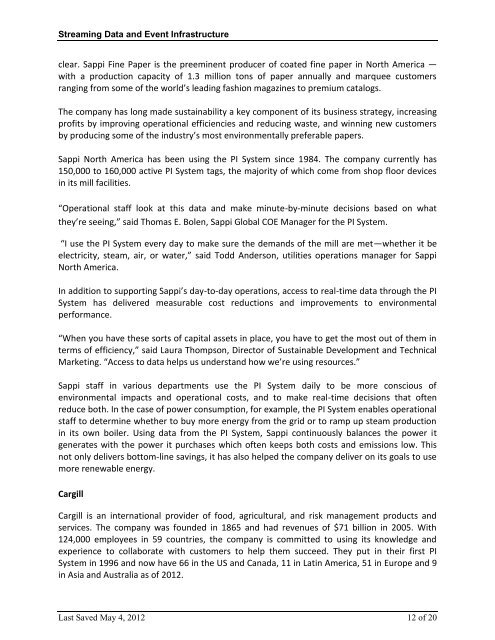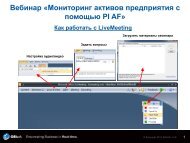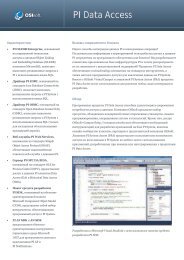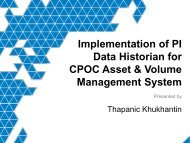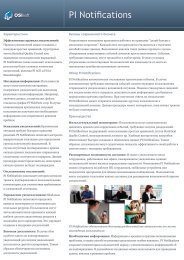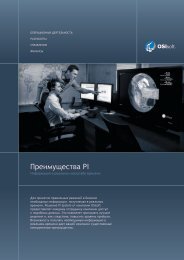Streaming Data and Event Infrastructure - OSIsoft
Streaming Data and Event Infrastructure - OSIsoft
Streaming Data and Event Infrastructure - OSIsoft
You also want an ePaper? Increase the reach of your titles
YUMPU automatically turns print PDFs into web optimized ePapers that Google loves.
<strong>Streaming</strong> <strong>Data</strong> <strong>and</strong> <strong>Event</strong> <strong>Infrastructure</strong><br />
clear. Sappi Fine Paper is the preeminent producer of coated fine paper in North America —<br />
with a production capacity of 1.3 million tons of paper annually <strong>and</strong> marquee customers<br />
ranging from some of the world’s leading fashion magazines to premium catalogs.<br />
The company has long made sustainability a key component of its business strategy, increasing<br />
profits by improving operational efficiencies <strong>and</strong> reducing waste, <strong>and</strong> winning new customers<br />
by producing some of the industry’s most environmentally preferable papers.<br />
Sappi North America has been using the PI System since 1984. The company currently has<br />
150,000 to 160,000 active PI System tags, the majority of which come from shop floor devices<br />
in its mill facilities.<br />
“Operational staff look at this data <strong>and</strong> make minute-by-minute decisions based on what<br />
they’re seeing,” said Thomas E. Bolen, Sappi Global COE Manager for the PI System.<br />
“I use the PI System every day to make sure the dem<strong>and</strong>s of the mill are met—whether it be<br />
electricity, steam, air, or water,” said Todd Anderson, utilities operations manager for Sappi<br />
North America.<br />
In addition to supporting Sappi’s day-to-day operations, access to real-time data through the PI<br />
System has delivered measurable cost reductions <strong>and</strong> improvements to environmental<br />
performance.<br />
“When you have these sorts of capital assets in place, you have to get the most out of them in<br />
terms of efficiency,” said Laura Thompson, Director of Sustainable Development <strong>and</strong> Technical<br />
Marketing. “Access to data helps us underst<strong>and</strong> how we’re using resources.”<br />
Sappi staff in various departments use the PI System daily to be more conscious of<br />
environmental impacts <strong>and</strong> operational costs, <strong>and</strong> to make real-time decisions that often<br />
reduce both. In the case of power consumption, for example, the PI System enables operational<br />
staff to determine whether to buy more energy from the grid or to ramp up steam production<br />
in its own boiler. Using data from the PI System, Sappi continuously balances the power it<br />
generates with the power it purchases which often keeps both costs <strong>and</strong> emissions low. This<br />
not only delivers bottom-line savings, it has also helped the company deliver on its goals to use<br />
more renewable energy.<br />
Cargill<br />
Cargill is an international provider of food, agricultural, <strong>and</strong> risk management products <strong>and</strong><br />
services. The company was founded in 1865 <strong>and</strong> had revenues of $71 billion in 2005. With<br />
124,000 employees in 59 countries, the company is committed to using its knowledge <strong>and</strong><br />
experience to collaborate with customers to help them succeed. They put in their first PI<br />
System in 1996 <strong>and</strong> now have 66 in the US <strong>and</strong> Canada, 11 in Latin America, 51 in Europe <strong>and</strong> 9<br />
in Asia <strong>and</strong> Australia as of 2012.<br />
Last Saved May 4, 2012 12 of 20


